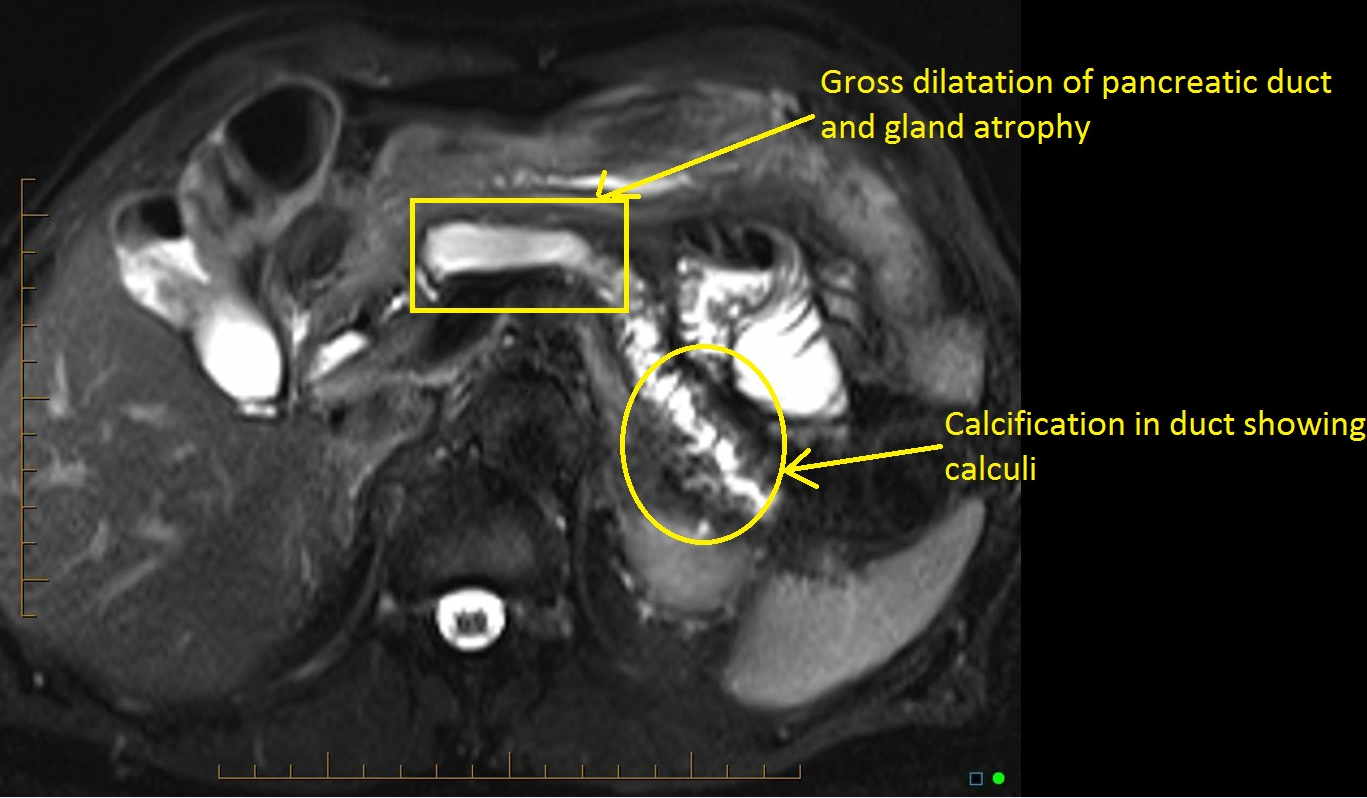Chronic pancreatitis MRI
|
Chronic pancreatitis Microchapters |
|
Diagnosis |
|---|
|
Treatment |
|
Case Studies |
|
American Pancreatic Association Practice Guidelines |
|
Chronic pancreatitis MRI On the Web |
|
American Roentgen Ray Society Images of Chronic pancreatitis MRI |
|
Risk calculators and risk factors for Chronic pancreatitis MRI |
Editor-In-Chief: C. Michael Gibson, M.S., M.D. [1]; Associate Editor(s)-in-Chief: Iqra Qamar M.D.[2]
Please help WikiDoc by adding more content here. It's easy! Click here to learn about editing.
Overview
MRI findings for chronic pancreatitis may be classified as early and late findings. Early findings may include low-signal-intensity pancreas on T1-weighted fat-suppressed images, decreased and delayed enhancement after IV contrast administration and dilated side branches. Late findings may include parenchymal atrophy or enlargement, pseudocyst formation, dilatation and beading of the pancreatic duct with intraductal calcifications giving an appearance of 'chain of lakes'.
MRI
1. Morphological findings:
Features of chronic pancreatitis can be divided into early and late findings:[3][4][5][6]
(a) Early findings:
- Low-signal-intensity pancreas on T1-weighted fat-suppressed images
- Decreased and delayed enhancement after IV contrast administration
- Dilated side branches
(b) Late findings:
- Parenchymal atrophy or enlargement
- Pseudocyst formation
- Dilatation and beading of the pancreatic duct with intraductal calcifications can give an appearance of 'chain of lakes'.

References
- ↑ Balakrishnan V, Chatni S, Radhakrishnan L, Narayanan VA, Nair P (2007). "Groove pancreatitis: a case report and review of literature". JOP. 8 (5): 592–7. PMID 17873465.
- ↑ Blasbalg R, Baroni RH, Costa DN, Machado MC (2007). "MRI features of groove pancreatitis". AJR Am J Roentgenol. 189 (1): 73–80. doi:10.2214/AJR.06.1244. PMID 17579155.
- ↑ Miller FH, Keppke AL, Wadhwa A, Ly JN, Dalal K, Kamler VA (2004). "MRI of pancreatitis and its complications: part 2, chronic pancreatitis". AJR Am J Roentgenol. 183 (6): 1645–52. doi:10.2214/ajr.183.6.01831645. PMID 15547204.
- ↑ Sanyal R, Stevens T, Novak E, Veniero JC (2012). "Secretin-enhanced MRCP: review of technique and application with proposal for quantification of exocrine function". AJR Am J Roentgenol. 198 (1): 124–32. doi:10.2214/AJR.10.5713. PMID 22194487.
- ↑ Bian Y, Wang L, Chen C, Lu JP, Fan JB, Chen SY, Zhao BH (2013). "Quantification of pancreatic exocrine function of chronic pancreatitis with secretin-enhanced MRCP". World J. Gastroenterol. 19 (41): 7177–82. doi:10.3748/wjg.v19.i41.7177. PMC 3819555. PMID 24222963.
- ↑ Hansen TM, Nilsson M, Gram M, Frøkjær JB (2013). "Morphological and functional evaluation of chronic pancreatitis with magnetic resonance imaging". World J. Gastroenterol. 19 (42): 7241–6. doi:10.3748/wjg.v19.i42.7241. PMC 3831205. PMID 24259954.
- ↑ a href="https://radiopaedia.org/">Radiopaedia.org. From the case href="https://radiopaedia.org/cases/17014">rID: 17014